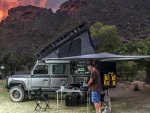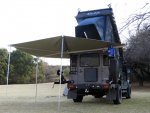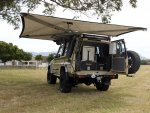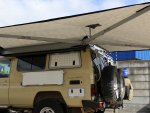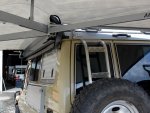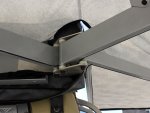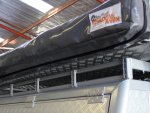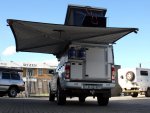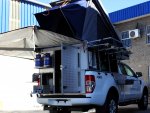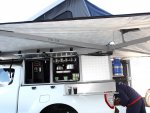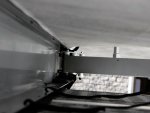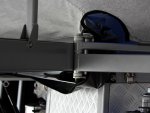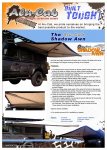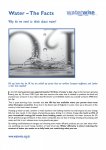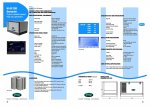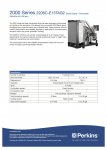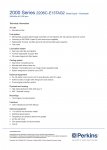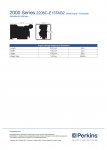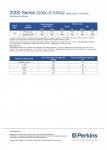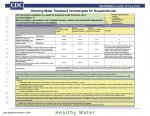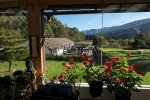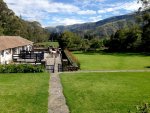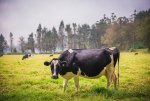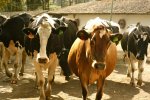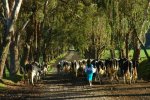You can get 300 KW out of a fully charged 300 KW battery. Inefficiency means that you have to put more than 300 KW into it.
However, Li-ion charging is more complex than that.
1. The proper charging procedure is to CC-CV or constant-current constant-voltage.
This means that the charger charges with high current until the battery is mostly full. They tops it off with constant voltage (and dropping current). You may have it hard to top your battieries off like that in a truck, I don't know what do hybrid manufacturers do.
2. The faster you charge, the lower battery capacity is.
3. The faster you discharge, the less energy you get out.
Points 2 and 3 make large batteries desirable, 100 kW from 100 kWh battery will discharge it in 1 hour. This rate is called 1 C. 100 kW from 300 kWh battery is 0.33C, much better. Optimal charge and discharge rates vary across chemistries, see:
http://www.batteryuniversity.com/learn/article/types_of_lithium_ion
So the 80% efficiency will probably show on both sides of 300 KW, you'll get more in and less out. Tesla says that their batteries actual capacity is 95% of the rated one. Maybe fast discharge is one of reasons? Maybe that's also one of reasons why Tesla claims 92% efficiency (they use the rated capacity) and users report less, at peak load they discharge the 70 kWh pack at over 8C.
http://www.batteryuniversity.com/learn/article/types_of_lithium_ion says that NMC cells shouldn't exceed 2C. Though few users will exceed 2C (or 140 kW from the battery, some less at the wheels) regularly.
Anyway, assuming that you'll take 285 kWh from a 300 kWh-rated pack looks to be on the safe side.
I don't have information to guess gearbox inefficiency. But I have a question. Where do you want to have that gearbox? In each wheel? A complex setup... In some wheels would be a possible compomise.
Just a few more questions that occurred to me after re-reading the post above, which you wrote a few pages ago. Very interesting to learn that there are different types of Lith-Ion, and that Tesla chose
Lithium Nickel Cobalt Aluminum Oxide (LiNiCoAlO[SUB]2[/SUB]) -- see http://www.batteryuniversity.com/learn/article/types_of_lithium_ion .
***********************************************
1. Some Questions about "C"
***********************************************
First off, I still don't quite understand "C", even though I read the explanation at
http://batteryuniversity.com/learn/article/what_is_the_c_rate . As we move towards faster charging/discharging, C goes above 1, yes? And as we move towards slower charging/discharging, C drops below 1, right? So the problem with fast-charging is that one needs a bigger battery in order to store the same amount of power, as one would if one were charging more slowly instead. In addition, the basic problem with a Tesla battery, is that it wants to be recharged at 0.7 C. This means something to the effect that if a Tesla battery pack is 100 KW, then it wants to be recharged by a 100 KW generator in 1.42 hours, not just 1 hour. Is this right? Am I basically on track?
So in some ways a NMC battery might be better, because it can accept a 1 C charge rate. There will still be the 20 % inefficiency loss, so after one hour a 280 KW generator will still only have re-charged a 300 KW NMC pack to 224 KW. But at least the rate won't have to be slower than that, because NMC"s "C" is 1, and not 0.7.
Now when you wrote
"Definitely", were you suggesting that by 2020 the "C" rate for Tesla's choice of Lith-Ion chemistry may have improved, and reached 1 C?
Furthermore, in the quote above you seemed to indicate that it would be wise to assume that the TerraLiner will only get 285 kWh out of a 300 kWh battery battery pack. So there is inefficiency on both sides, putting in and taking out. To keep things simple, I have been trying to choose very "round" numbers. So should I be imagining the TerraLiner carrying a 316 KW battery pack, so that it can actually draw out 300 KW, assuming 95 % efficiency when withdrawing? If using the same generator, then this means 88 minutes to recharge 316 KW, instead of 80 minutes to recharge 300 KW (in both cases assuming 80 % re-charging efficiency).
***********************************************
2. Can I go forward with my very rough estimates of what might be possible in 2020?
***********************************************
My next question is then this. Can I just ignore such details, and figure that by 2020 not only will the TerraLiner be able to recharge 300 KW in 1 hour and 20 minutes or less using 280 KW generator, but it would also be probably be able to recharge 316 KW in the same amount of time?
In other words, because I am allowing myself to imagine 4 years into the future, can I rough-ballpark guess that 100 liters used by a Perkins 280 KW generator will be enough to recharge a large battery pack (one that's probably 316 KW), out of which the TerraLiner will then be able to withdraw 300 KW? Everything simplifies beautifully if the answer is "yes". If energy consumption in a very hot climate is 100 KW per day, then recharging the 316 KW battery will require 100 liters of diesel fuel every three days, without help from solar. Even though the battery is 316 KW, the TerraLiner will only get 300 KW back out of that, ergo, exactly three days. So even without any contribution from solar, the TerraLiner could "high-energy-usage" camp for 45 days, with a 1500 liter fuel tank.
I just need to know that I can move forward with some degree of confidence; that I can trust that this will be possible circa 2020. Would such an assumption be "conservative", "about right", or "optimistic"?
***********************************************
3. Why "C" needs to be high: reducing generator run-time to an absolute minimum
***********************************************
One reason I am asking about charging time is of course fuel consumption. Longer charging, more fuel consumed. "C" could be lowered by having the generator operate at 50 % power for twice as long. Fuel efficiency goes down a bit, and the generator would then consume 80 liters of fuel, to produce the same amount of power that it did when operating at 100 % and consuming 75 liters of fuel:

But perhaps charging only half as fast would increase battery efficiency, so things would work out more or less the same?
The other big factor to consider is noise. Running the generator for just 1 hour 20 minutes at most every 3 days, and probably more like just once a week, is not going to bother any farmer. But running the generator for 3 hours instead at half-speed, would be more disturbing. The whole idea behind having a big battery pack as well as a very powerful generator, is that camping could then become "mostly silent". Asking a farmer if one might be allowed to run the TerraLiner's primary generator for just an hour or two every week would not be a "deal-breaker" request. Whereas if instead one were to ask a farmer if the TerraLiner could run a 20 KW generator almost around the clock, he might think twice before allowing one to rent his land.
***********************************************
4. One major TerraLiner camper design objective: maximizing off-grid boondocking time between refuelings
***********************************************
Remember, one my main concerns in all of this, from a design/engineering point of view, will be thinking about how the solar panels could then supplement the generator, so that off-grid boondocking could be extended to 90 days, even in a high-energy consumption scenario (100 KW per day). And even if DNI were only about average, meaning that 19 KW of solar arrays in total would yield only about 50 KW of power daily. The ultimate design/engineering objective here is being able to dry-camp for as long as possible without refueling.
A more fuel-efficient generator would certainly help, e.g. one that could recharge 316 KW using just 90 liters of fuel, instead of 100 liters. And more efficient batteries that do not lose as much energy charging/discharging would also help. But the most important part, from a design point of view, will be providing enough surface area in the TerraLiner's layout such that the solar arrays
are producing 50 KW per day, even in a hot equatorial climate where often it is raining and/or there is significant cloud cover, and where DNI is not optimal even though the sun is directly overhead. As I've been working things through, it does seem like 90 days of dry camping without refueling
would be possible in a hot equatorial climate, just as long as the solar cells were producing 50 KW per day.
All of this begins to make the TerraLiner seem uniquely attractive, from a boondocking point of view. The TerraLiner might well prove to be the
"ultimate large expedition motorhome for boondocking", because it will be so autonomous.
No, this does not mean that the TerraLiner will be the "ultimate expedition motorhome" more generally. There is no such thing. But most motorhomes -- even expedition motorhomes -- are not designed for 90 days of complete off-grid independence. And especially not such extended independence combined with high energy consumption, and full A/C in a hot climate when the Heat Index rises above 100. Even expedition motorhomes can only boondock for months via conservation and rationing of everything -- water, power, food. Whereas I am deliberately targeting a design goal where off-grid living for 3 months will not be draconian, and the TerraLiner's occupants will be living like comfortable Floridians in an air-conditioned home.
***********************************************
5. Hacienda Zuleta
***********************************************
To provide some idea of the kind of "farm camping" that I have in mind, I want to briefly discuss a very beautiful Eco-Lodge located in Ecuador, called "Hacienda Zuleta". Although it is not situated in a hot climate, discussing Hacienda Zuleta will allow me to vividly illustrate some thoughts about TerraLiner logistics, and one way that it might find accommodating farms where it can camp in Second and Third-World countries.
Hacienda Zuleta is a working farm, and the family home of an ex-president of Ecuador -- see
http://zuleta.com ,
http://zuleta.com/hacienda-zuleta/ ,
http://zuleta.com/location-of-hacienda-zuleta-ecuadorian-andes/ ,
http://zuleta.com/history-of-hacienda-zuleta-in-ecuador/ ,
http://zuleta.com/working-farm-and-agrotourism-in-ecuador/ ,
http://zuleta.com/destinations-in-highland-ecuador/local-sustainable-dairy-farm-in-ecuador/ ,
http://zuleta.com/destinations-in-h...den-and-agriculture-in-ecuador-south-america/ , and
http://zuleta.com/media/ . The Hacienda is located about 100 km north of Quito, just a few hours by car from the capital. It sits at an elevation of about 3000 m, and has a temperate climate that does not change very much year-round, because it's right on the equator. In effect, it has a year-round "spring" climate. So A/C would not be necessary during the day, and at night only a bit of heat.
The Hacienda has 2112 hectares, 300 dairy cows, 100 horses, 2000 sheep, a trout farm, an organic garden, and terrific views of the surrounding volcanoes. It is the ideal "Eco-Lodge" or
"agriturismo", because it has so many amenities. Many agriturismi in Italy are just large rural properties with a few olive trees, and not much in the way of a true working farm. More upscale, they are really just rural boutique hotels. More downscale, they are really just B&Bs. Alternatively, some agriturismi are true working farms, but the "Eco-Lodge" side of things is weak. Hacienda Zuleta is then very special because both sides of the operation are strong and genuine. It is both an upscale boutique hotel, as well as a genuine working farm and ranch. Furthermore, it is a major riding center and choice destination for equine tourism -- see
https://www.inthesaddle.com/rides/view/159_haciendazuleta_andes_ecuador ,
http://www.coxandkings.co.uk/destin...d-the-galapagos/accommodation/hacienda-zuleta , and
http://www.abercrombiekent.co.uk/ecuadorandgalapagosislands/otavalo/zuleta.cfm ,
https://www.inthesaddle.com/rides/view/159_haciendazuleta_andes_ecuador . I have visited lots of boutique hotels, lots of riding centers, lots of organic farms, and lots of working farms. But I don't think I have ever stayed at a working farm that is also a top-class boutique hotel, as well as an organic farm, a fish farm, and a major riding center:


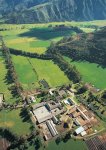
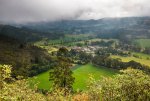

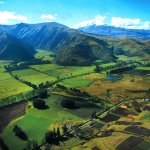
**************************************************
CONTINUED IN NEXT POST
.



